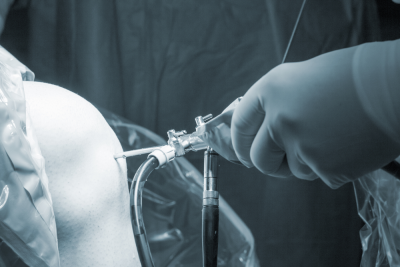Arthroscopy is a surgical procedure orthopedic surgeons use to visualize, diagnose, and treat problems inside a joint. The word arthroscopy comes from two Greek words, "arthro" (joint) and "skopein" (to look). The term literally means "to look within the joint."
In an arthroscopic examination, an orthopedic surgeon makes a small incision in the patient's skin and then inserts pencil-sized instruments that contain a small lens and lighting system to magnify and illuminate the structures inside the joint. Light is transmitted through fiber optics to the end of the arthroscope that is inserted into the joint.
By attaching the arthroscope to a miniature television camera, the surgeon is able to see the interior of the joint through this very small incision rather than a large incision needed for surgery. The television camera attached to the arthroscope displays the image of the joint on a television screen, allowing the surgeon to look, for example, throughout the knee. This lets the surgeon see the cartilage, ligaments, and under the kneecap. The surgeon can determine the amount or type of injury and then repair or correct the problem, if it is necessary.
Arthroscopy can be helpful in the diagnosis and treatment of many noninflammatory, inflammatory, and infectious types of arthritis as well as various injuries within the joint.
Noninflammatory degenerative arthritis, or osteoarthritis, can be seen using the arthroscope as frayed and irregular cartilage. A new procedure for the treatment of younger patients with an isolated injury to the cartilage covering the bone ends within a joint uses a "paste" of the patient's own cartilage cells. The cells are harvested and grown in the laboratory and are then reimplanted at a later date in the knee with the use of an arthroscope.
In inflammatory arthritis, such as rheumatoid arthritis, some patients with isolated chronic joint swelling can sometimes benefit by arthroscopic removal of the inflamed joint tissue (synovectomy). The tissue lining the joint (synovium) can be biopsied and examined under a microscope to determine the cause of the inflammation and discover infections, such as tuberculosis. Arthroscopy can provide more information in situations which cannot be diagnosed by simply aspirating (withdrawing fluid with a needle) and analyzing the joint fluid.
Common knee joint injuries for which arthroscopy is considered include cartilage tears (meniscus tears), ligament strains and tears, and cartilage deterioration underneath the kneecap (patella). Arthroscopy is commonly used in the evaluation of knees and shoulders but can also be used to examine and treat conditions of the hips, wrist, ankles, fee, spine, and elbows.
Finally, loose tissues, such as chips of bone or cartilage, or foreign objects, such as plant thorns or needles, which become lodged within the joint, can be removed with arthroscopy.
REFERENCES
https://orthoinfo.aaos.org/en/treatment/arthroscopy/
https://www.mayoclinic.org/tests-procedures/arthroscopy/about/pac-20392974

